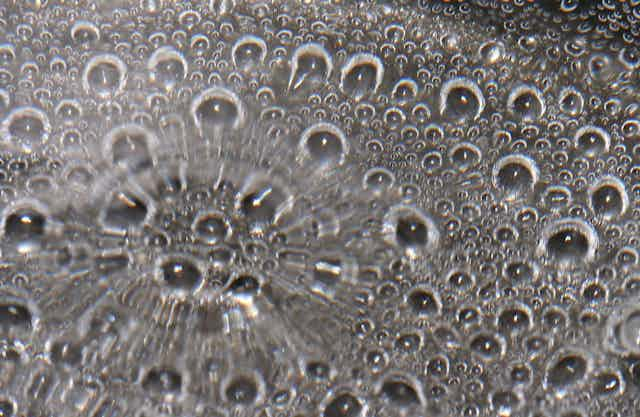Imagine a specially-engineered surface that could allow liquids to boil without bubbling. This sounds counter-intuitive and, in a way, it is. But consider the following.
When a small drop of water is dropped onto a very hot frying pan, it skitters around and takes up to a minute to evaporate. A video of this phenomenon is embedded below.
On initial contact, the hot surface vaporises part of the drop and creates an insulating vapour layer between the drop and the hot surface, much like the air gap in a double-glazed window. This vapour layer can only be sustained if the hot surface is above the so-called Leidenfrost temperature. It also acts as an efficient lubricant and can reduce the drag on a hot sphere travelling through water by up to 85%.
The Leidenfrost vapour layer also plays an important part in boiling and cooling. If in place of small drops of water in a hot frying pan, we have a hot kettle filled with water, the Leidenfrost vapour layer will collapse when the kettle cools below the Leidenfrost temperature, resulting in an explosion of vapour bubbles as the water makes direct contact with the (still) hot surface.
Until recently, this rather violent explosive ending for vapour, reminiscent of the death throes of a star, was thought to be inevitable when a hot surface in contact with water cooled below the Leidenfrost temperature.
Everything changes
In a report published yesterday by my colleagues and I in the journal Nature, it was found that by modifying the heating surface to give it nano-scale roughness and a coating to render it highly water repellent – or super-hydrophobic – the Leidenfrost vapour layer can be sustained at all surface temperatures, thereby eliminating the vapour explosion.
A video illustrating our work can be watched below:
The research was undertaken by members of the University of Melbourne, the King Abdul University of Science and Technology, Saudia Arabia, and Northwestern University in the US.
It might sound a little complicated but the way it works is simplicity itself. The rough, water-repellent surface acts like the fakir bed of nails so that the water rests on the peaks of the rough nano-scale surface layer and makes very little solid-liquid contact.

With the right combination of roughness and chemical modification, the bubble explosion resulting from collapse of the Leidenfrost vapour layer can be suppressed.
These results may be useful in applications in which “quiet” boiling is required – whether it be for a non-intrusive kettle or boilers that generate minimal vibrations and noise.
The general principle this work reveals is that, in any process in which heat is transferred between a solid and a liquid during heating, cooling or freezing – or more generally a change of phase – the surface properties of the solid heat source or sink should be factored into the design.
Examples of potential areas of application may be controlling ice formation on the ailerons of aircrafts, the fogging and frosting of mirrors and windows and in refrigeration, in which the liquid coolant is a refrigerant, not water.
If you thought liquids had to come to an explosively violent end, we may just have burst your bubble.

